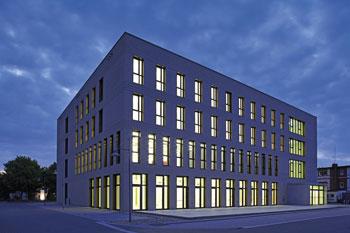Efficiency through building automation
In the Bielefeld Technical College, a new building shows how building automation can improve energy efficiency. Wago controllers play a central role in plant and room automation
by Silvia Foglio
The new building of Applied Sciences for the Minden Campus of Bielefeld Technical College integrates cutting-edge energy and automation technology, and is also an example of cross-discipline, integrated construction. Due to close collaboration, the designers and building trades reached a precise target in quality and costs. The University and BLB NRW, a property management and construction company, have collaborated: after 22, BLB NRW the new building has been completed and within the 14 million euro budget.
Achieving the consumption values required for class A
The University of Applied Sciences wanted an intelligent building with sophisticated energy and automation technology. BLB NRW designed a four-story “meeting center”, with offices, work spaces, a library, and a cafeteria, which also functions as a research and teaching facility due to the modern energy systems and intelligent building technology. Lighting, energy generation and distribution, air conditioning, and sun protection are automatically controlled and monitored using building automation that covers all the skilled trades and extends from individual systems up to complete room automation. The Minden campus construction is currently one of two university buildings in the country that already fulfills the high demands of energy efficiency class A. According to the Energy Saving Ordinance of 2014, this mean that no more than 50 kilowatt hours per year, in the form of electricity and heat, can be consumed per square meter. Investments in room automation are necessary in order to achieve the consumption values required for class A. However, public-sector budgets are not sufficient for the standards. For the campus project, the University of Applied Sciences took responsibility for the costs of the intelligent building automation, for a total of 113,000 euros.
Investments in automation allows operating cost savings
The decisive argument: building automation may have higher initial costs; however, the investment more than pays for itself through operating cost savings over the lifetime of the building. To increase energy savings, the building includes a well-insulated structural shell, recovers waste heat from the servers in the computer lab, and supplements with energy from a geothermal system. Its probes draw warmth from the earth which is transferred to a heat pump, which in turn increases the low temperature of the geothermic warmth in order to heat the building. Due to the reversible operation of the heat pump, the library, cafeteria, foyer, meeting areas, and workshop are cooled using the underfloor heating system and radiant ceiling panels – and energy extracted here is used to regenerate the ground probe field. A second heat pump is linked into the combined storage for the server cooling/geothermic system, and is also used for the combined heating system. A gas condensing boiler provides hot water and is reserved for peak loads. Cooling peaks are accommodated by two chillers. In addition, free cooling is integrated into the combined cooling system. The entire system technology is designed to minimize primary energy consumption.
Open communication to ensure a proper central systems function
BACnet/IP controllers from the Wago-I/O-System 750 play a central role in plant and room automation. A total of 21 of these systems were installed in the new building. Seven controllers comprise the classic information nodes for heating, air-conditioning and refrigeration, and 14 units take on the automation functions for the individual floors. All control units are networked together via an Ethernet network. BACnet provides a standardized, open-source data communication protocol, which enables data communication between devices from different manufacturers according to the detailed specifications of the construction planning. As controllers for the instrumentation, control, and automation technology, the Wago technology ensures that the central systems – like the heat pumps or the geothermal system – function problem-free, and that these systems, in conjunction with ventilation, always provide the desired temperature.
Building automation is monitored and adjusted at any time
Room automation includes lighting, sun shades, and room temperature regulation. Carbon dioxide air quality controllers are also in use in the practical labs and seminar rooms. Feedback signals from the window contacts are likewise detected and processed in the automation programming. In order to detect all of the signals at the room level, Hermos uses the modular structure of the Wago-I/O-System and special connectors for the DALI, KNX, and SMI sub-bus systems The different room functions are activated via KNX room operating panels. According to the specifications in the system integration sheets, all facility and room automation information, as well as additional monitoring functions for all building systems are linked to a BACnet management service level in order to monitor and adjust the building automation at any time. With their help, the building’s energy data can be recorded and analyzed, the setpoints or occupancy times can be changed, and all values and conditions, such as temperatures, operating messages and faults from all systems, can be visualized as both a forecast and review using time-lapse. Trained WAGO experts closely examined the building technology in Minden as part of the eu.bac certification process. The systematic evaluation helps obtain targeted savings in energy and operating costs over the entire life cycle. To this end, the eu.bac system certification for buildings sets new standards.

